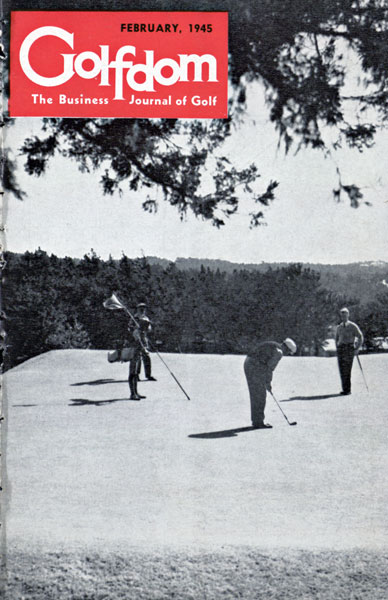The Golfdom Files: Lessons in wartime upkeep
A handful of problems can touch superintendents, no matter the location. One frequently mentioned during 2015 was the difficulty of finding good crew members. The reasons for this issue vary from region to region, but we can be thankful it’s not the labor shortage the golf industry faced during World War II. In the February 1945 Golfdom, Andy High wrote about golfer standards for a golf course during that time and how one Kansas course kept its greens in good condition.
By Andy High
 Two seasons of war-condition upkeep have taught that it is possible to bypass many of the operating difficulties resulting from shortages in course maintenance, labor, machinery and supplies.
Two seasons of war-condition upkeep have taught that it is possible to bypass many of the operating difficulties resulting from shortages in course maintenance, labor, machinery and supplies.
The more alert greenkeepers have developed resourcefulness in licking most of the problems of wartime upkeep, and the lessons they have learned will stand them in good stead and benefit their clubs for years to come.
The greens are the great labor, machine and materials problems of these extraordinary times. Fairway maintenance problems have been solved for the time being with less frequent cutting, narrowing and shortening. Golfers, for their part, in many cases have offset lower standards of fairway maintenance by exercising winter fairway rules the year round. True, but on the other hand, many clubs have found it necessary to lower the height of their rough cutting to help meet the acute golf ball shortage. Shrubbery and trees have remained untrimmed, fences and bridges have been neglected as well as many other details that received constant attention during normal times. Yet I have heard but little complaining in this direction.
But throughout, the golfer has retained his right to expect good greens and raise hell in general about poor greens.
For the past two seasons I have, through the gracious transient system of the Army, played courses in Missouri, Illinois, Nebraska and Kansas (and these the finer metropolitan courses), and in each found the common problem; the greens, the common complaint, the greens; and the common stock excuse, shortages due to war conditions.
For the future benefit of courses that have been unable to meet this problem, I wish to cite the procedure of care of greens on the White Lakes GC, Topeka, Kansas. This club has had for the whole season greens equal to the average peacetime greens. The total labor force for the season has been one man, the owner, Mr. E. E. Brunkow, and the occasional help of two boys.
Most important, whereas many greens throughout this area have suffered, the greens of White Lakes were as lovely in late October as they were in June.
The first step, starting with the first mowing, was a systematic reduction of the size of the greens. This was not a great reduction, for the sum total reduction would not constitute the footage of one average-sized green. But for a whole season, just a lap or two less on each of the 18 holes is no small item in manpower and economy. This reduction served another purpose — that of transplanting. This procedure eliminated the need of a seedbed and eliminated transportation of mat from a seedbed to far corners of the course. This saved time and actually provided a seedbed at the edge of each green. For the golfers, it provided the finest type of fringe.
For the later part of March and through April the greens were cut high, and only every other cutting was caught. This permitted the development of an extensive mat and some retention of the minerals lost in clippings. From April on, the mowers were lowered just enough to clip the accumulated fringiness. The greens in late October were uniformly matted, without semblance of spottiness, and with a mat of from three-fourths to 1 inch in depth.
Photos: Golfdom









